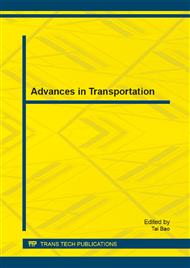p.1114
p.1118
p.1122
p.1127
p.1133
p.1137
p.1143
p.1148
p.1153
Anticipation Driving Behavior in Car Following Theory
Abstract:
In this paper, a new anticipation driving car-following model (AD-TVDM) is presented based on the two velocity difference model (TVDM)[1], taking into the effect of anticipation driving behavior in real world. The nature of the model is investigated by using linear and nonlinear analysis method. A thermodynamic theory is formulated to describe the phase transition and critical phenomenon in traffic flow and the time-dependent Ginzburg-Landau (TDGL) equation is derived to describe the traffic flow near the critical point.
Info:
Periodical:
Pages:
1133-1136
Citation:
Online since:
January 2014
Authors:
Keywords:
Price:
Сopyright:
© 2014 Trans Tech Publications Ltd. All Rights Reserved
Share:
Citation:


